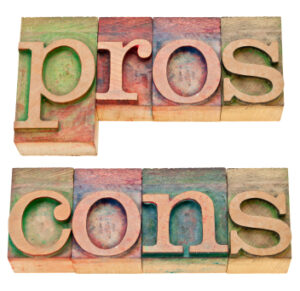Should You Offer Exclusives to Journalists?
 Your company has a huge announcement in the works. You’re gearing up to help spread the news out to the world. Suddenly you have a revelation: let’s offer it as an exclusive! That way our news will seem even bigger than it already is. Plus, we’ll have a unique deal with one media outlet, guaranteeing lots of coverage!
Your company has a huge announcement in the works. You’re gearing up to help spread the news out to the world. Suddenly you have a revelation: let’s offer it as an exclusive! That way our news will seem even bigger than it already is. Plus, we’ll have a unique deal with one media outlet, guaranteeing lots of coverage!
However, before you call your contact at NBC, you might want to sit back and consider. Yes, there are certain perks and pros to announcing your news through one source. But are the potential cons worth risking? Is your news actually big enough to warrant an exclusive, or are you doing it just because it seems “cool”?
What is an Exclusive?
Let me explain it simply:
An exclusive is when you give just one journalist or media outlet the first chance to cover your story before anyone else. It’s like giving someone “first dibs” on sharing your news.
Exclusive Examples
- – If Apple has a new iPhone coming out, they might give The Wall Street Journal the exclusive right to break the story first
- – If a celebrity is ready to share a personal story, they might give the exclusive to one specific TV show or magazine
- – If a company is announcing a major merger, they might let one business reporter have the exclusive story before telling other media
The key points about exclusives:
- Only one media outlet gets the story first
- They usually get special access (like interviews)
- They get to “break” the news before anyone else
- Other media typically have to wait until after the exclusive story is published before they can cover it
Think of it like inviting one friend to try your new recipe before sharing it with everyone else – that friend gets the special treatment of being first, which makes the story more valuable to them.
The Case for Exclusives
There’s no denying the power of an exclusive story. It just seems to make things more…enticing. When you hear something is an “exclusive,” it automatically gives the following information a little jolt of importance.
The power of an exclusive story can also help revitalize what could be a floundering message. Perhaps you’re worried your announcement will fall on deaf ears because of the excess of noise and confusion that’s out there in the world. It’s hard making a mark when so many are chattering away, trying to grab their own notoriety.
Giving one journalist or publication the rights to your story means they will be more invested in it. As a result, they will push a little harder for it to be heard. Therefore, you’ll have a better chance of others hearing your voice above the din!
This is extremely useful for startups who just can’t seem to find the right “hook” to make themselves known. Developing a relationship with one journalist or publication can guarantee that their voice will be heard – at least once. There’s a lot of competition out there and offering an exclusive story can make the difference between success and shutting the doors forever.
Plus, exclusives help with:
Building Strong Media Relationships
Offering an exclusive story to a journalist can help forge stronger relationships with key media contacts. When you give a reporter first access to valuable information, you demonstrate trust and provide them with an opportunity to break news in their field. This can lead to more favorable coverage and increased attention to your future announcements.
Greater Editorial Control
With an exclusive, you typically get more time to work closely with the journalist, ensuring they thoroughly understand your story. This often results in more accurate and detailed coverage compared to widely distributed press releases that may receive cursory treatment.
Increased Visibility
A well-placed exclusive can generate more substantial coverage than a broadly distributed announcement. Journalists are more likely to dedicate resources to stories they know their competitors don’t have, potentially resulting in longer articles, better placement, and more in-depth analysis.
Cons of Offering Exclusives
What’s the biggest limitation for an exclusive story? Considering if it’s actually worth the exclusivity in the first place!
One of my biggest pet peeves is when companies send out press releases for stuff that has no business getting announced. The same goes for contacting a journalist for an exclusive story. Does the story have any reason to be some big deal? Is it a major product launch or is someone moving up in the company? The latter could be interesting, but only if you’re a company like Apple. Otherwise, nobody probably cares.
Another major con of offering an exclusive is you risk alienating literally every other journalist or publication out there. As soon as you sent out an exclusive to, say, the New York Times, the Washington Post and USA Today are no longer your allies. When the story gains traction, they may or may not pick it up…but probably not, as you burned them before. Of course, if it’s big news they probably will pick it up, but they still may not be precisely on your side. There are two sides to every news story and if you burned bridges with one journalist well… they may be more inclined to look at the side that doesn’t show you in a favorable light.
Therefore, be extremely careful if deciding an exclusive story is good for your announcement. While the pros are heavy and it can be great for a message that may not be heard otherwise, the potential cons may have lasting effects you don’t want hanging around.
Other Drawbacks to Consider
Limited Reach
By restricting initial coverage to one outlet, you may miss opportunities for broader, simultaneous coverage across multiple publications. This could be particularly problematic if the chosen outlet’s audience doesn’t perfectly align with your target demographic.
Timing Risks
There’s always a risk that breaking news or other major stories could overshadow your exclusive, resulting in delayed publication or reduced prominence. With a broader media strategy, you have multiple opportunities for coverage.
Best Practices for Using Exclusives
1. Choose the Right Stories
Not every announcement warrants an exclusive. Reserve this approach for:
- Significant company news or launches
- Complex stories that benefit from in-depth reporting
- Announcements with broad market impact
- Stories with strong human interest elements
2. Select the Appropriate Outlet
Consider:
- Audience reach and demographics
- Reporter’s expertise in your subject matter
- Publication’s reputation and editorial standards
- Past coverage of your organization or industry
3. Set Clear Parameters
Establish upfront:
- Timeline for publication
- Scope of access to executives or information
- Whether follow-up interviews with other outlets will be permitted
- Any embargo periods or conditions
4. Have a Follow-up Strategy
Plan how you’ll:
- Share the story with other media outlets once it’s published
- Leverage the coverage across your own channels
- Handle requests from other journalists
- Maintain relationships with non-chosen outlets
When to Skip the Exclusive
Frankly, most situations favor a non-exclusive, broad distribution strategy, like:
- Crisis communications requiring widespread, immediate dissemination
- Regulatory disclosures that must be shared simultaneously
- Minor updates or routine announcements
- When timing is crucial and can’t be guaranteed with one outlet
The Hybrid Approach
Consider a hybrid strategy where you:
- Offer the exclusive angle to one outlet
- Prepare a broader announcement for other media
- Time the general release to follow shortly after the exclusive
This approach can maximize coverage while maintaining the benefits of an exclusive relationship.
Offer Exclusives or Not?
Media exclusives remain a valuable tool in the PR arsenal, but they should be used strategically. Success lies in choosing the right stories, selecting appropriate outlets, and maintaining balanced media relationships. By carefully weighing the benefits against the potential drawbacks, you can make informed decisions about when to offer exclusives and when to opt for broader distribution strategies.
Remember that the media landscape continues to evolve, and your approach to exclusives should adapt accordingly. What works today might need adjustment tomorrow, making it essential to regularly evaluate and update your media relations strategy.
This article is written by Mickie Kennedy, founder of eReleases (https://www.ereleases.com), the online leader in affordable press release distribution. Download your free copy of 8 Shocking Secrets Press Release Distribution Firms Don’t Want You to Know here: https://www.ereleases.com/landing3.html
